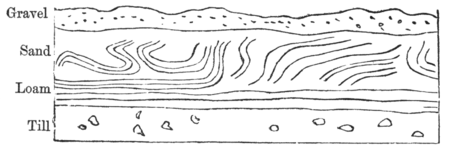This page has been validated.
220
GLACIAL DEPOSITS
CHAP. XII.
loose sand, loam, and pebbles, are so complicated that not only may we sometimes find portions of them which maintain
their verticality to a height of ten or fifteen feet, but they have also been folded upon themselves in such a manner that continuous layers might be thrice pierced in one perpendicular boring.
At some points there is an apparent folding of the beds round a central nucleus, as at a, fig. 30, where the strata seem
bent round a small mass of chalk, or, as in fig. 31, where the blue clay, No. 1, is in the centre; and where the other strata, 2, 3, 4, 5, are coiled round it; the entire mass being twenty



